Abstract
The activity of amphotericin B methyl ester was compared with that of amphotericin B, using Candida albicans (34 isolates), Torulopsis glabrata (12 isolates), Filobasidiella neoformans (stat. conid. Cryptococcus neoformans) (14 isolates), and Coccidioides immitis (37 isolates) and tube dilution in a totally synthetic, completely defined medium (SAAMF) with inocula of 104 colony-forming units per ml. Minimal inhibitory concentrations were read after 24 h at 34°C for C. albicans and T. glabrata, and after 48 h at 34°C for C. immitis and F. neoformans. Minimal lethal concentrations were determined by subculture of 10% of the volume of the cultures without evident growth onto Sabouraud glucose agar medium. Overall, amphotericin B methyl ester was slightly less active than amphotericin B, with the differences attaining statistical significance for: (i) inhibition of C. albicans and T. glabrata and (ii) killing of T. glabrata.
Full text
PDF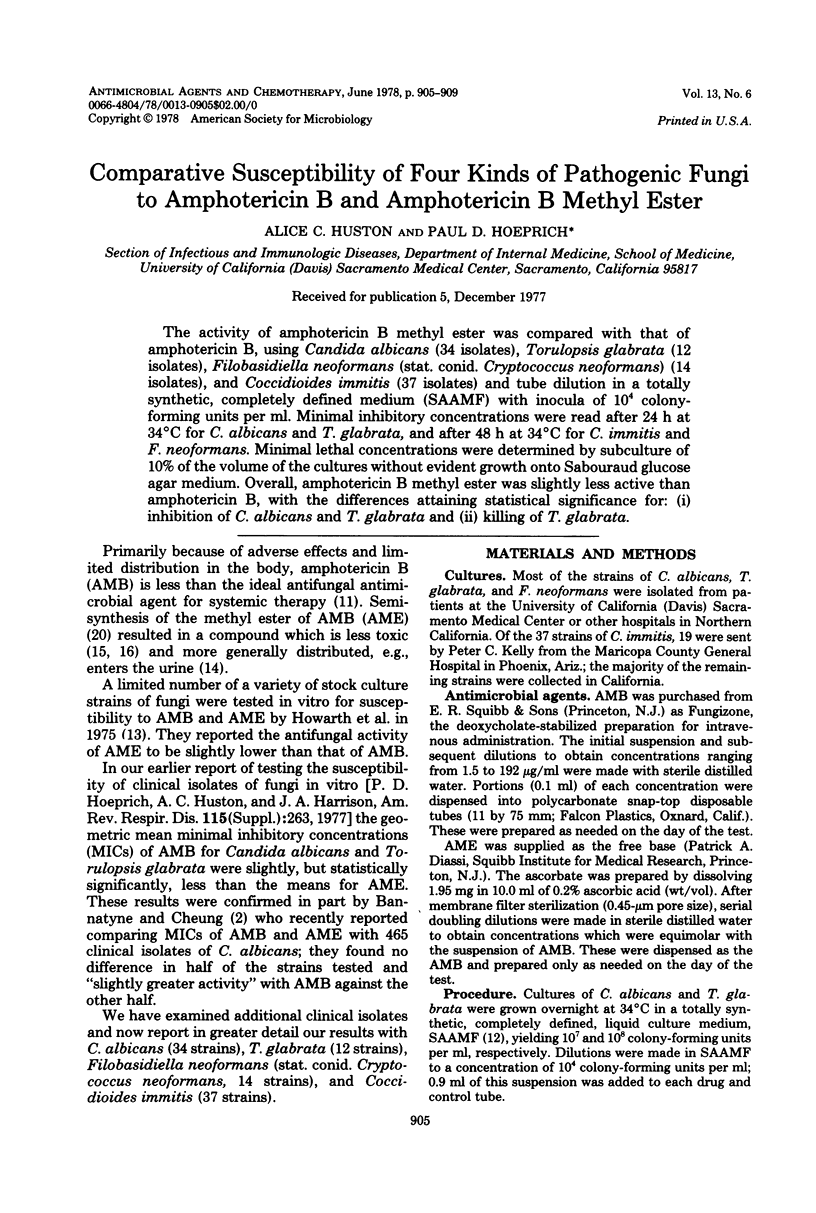
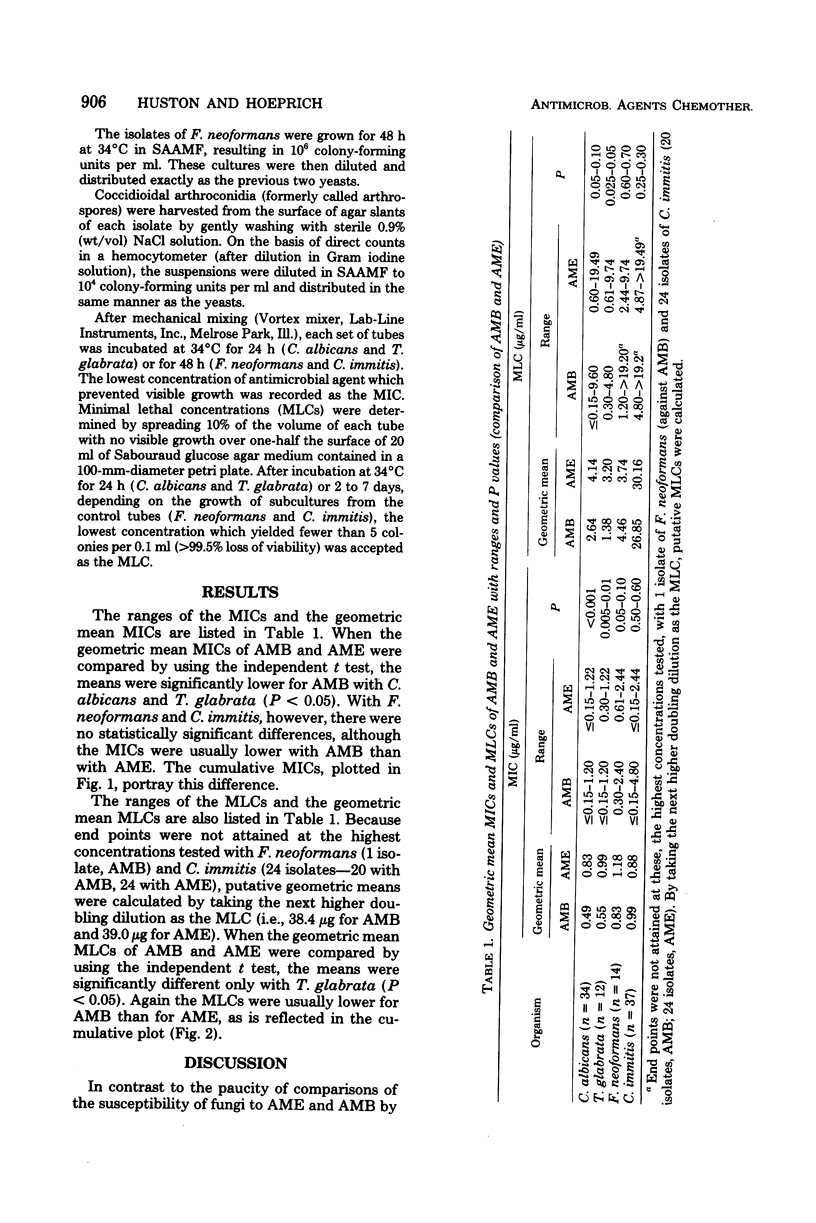
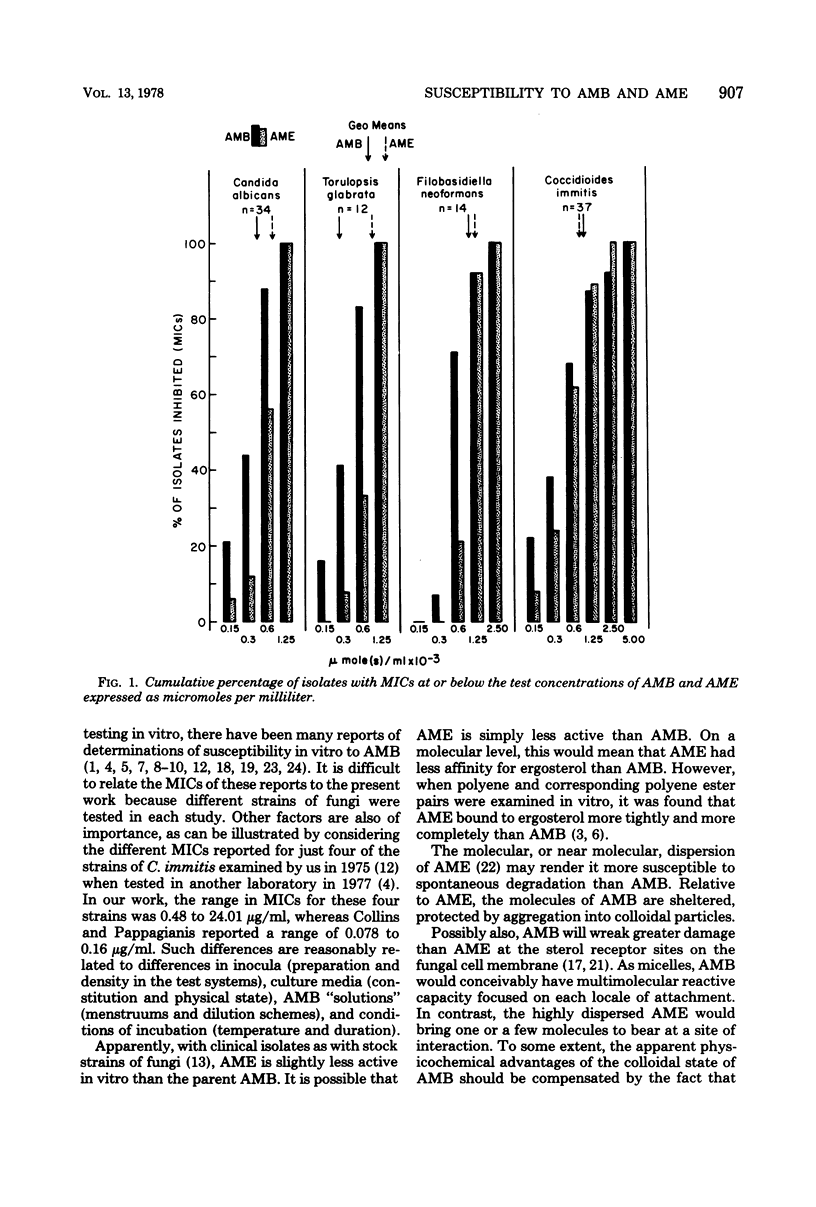
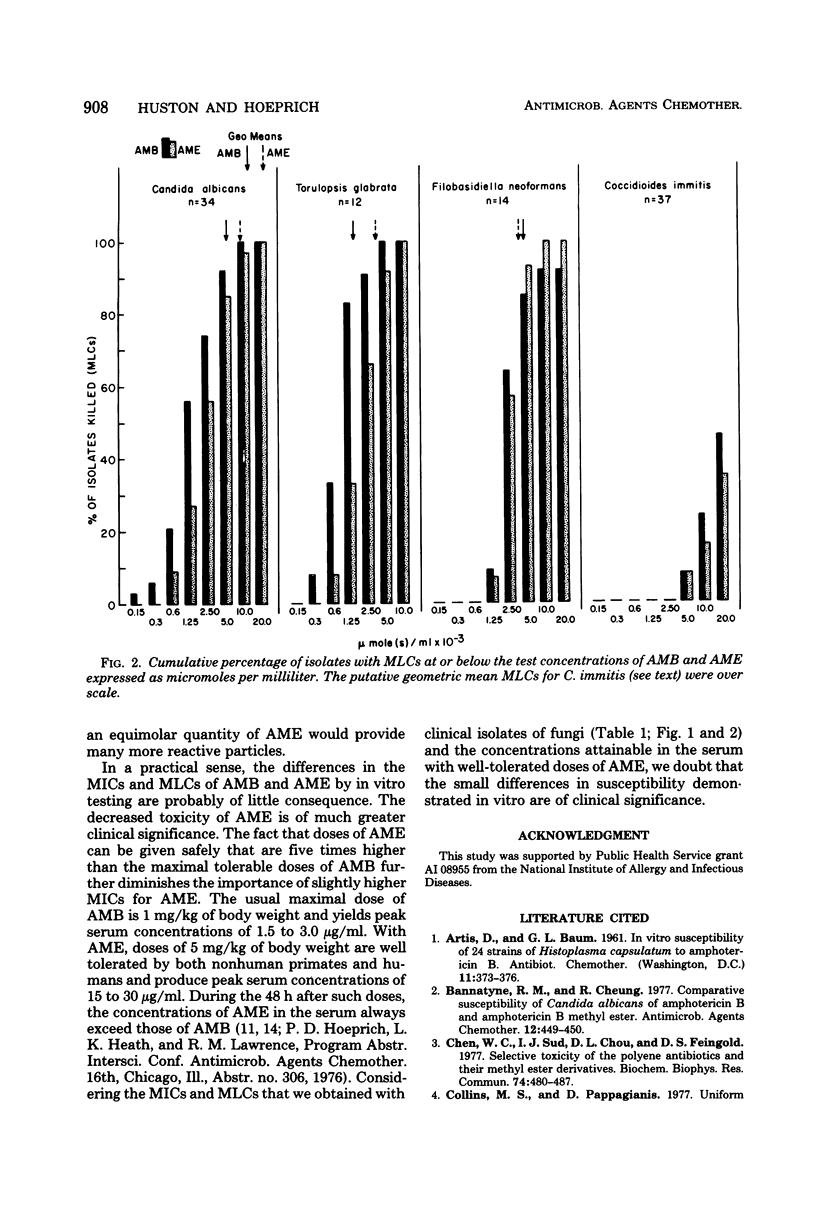
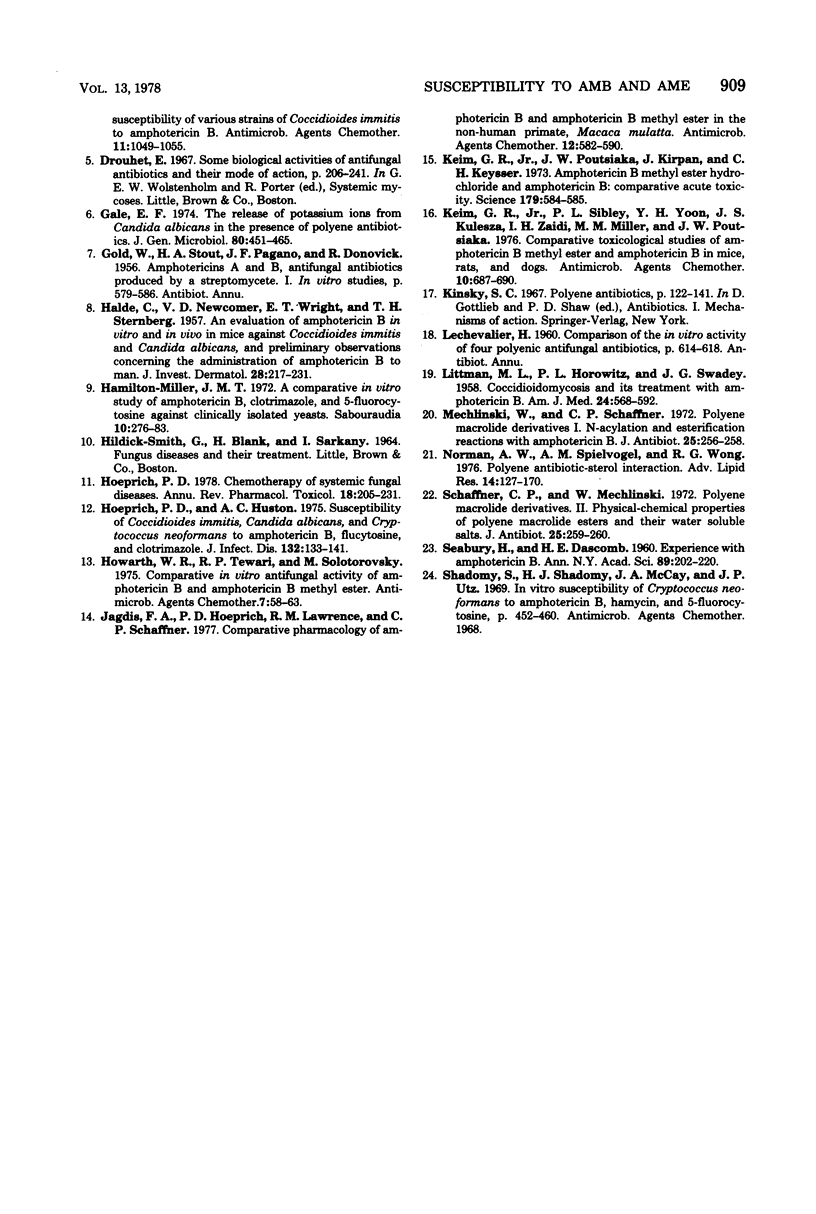
Selected References
These references are in PubMed. This may not be the complete list of references from this article.
- ARTIS D., BAUM G. L. In vitro susceptibility of 24 strains of Histoplasma capsulatum to amphotericin B. Antibiot Chemother (Northfield) 1961 Jun;11:373–376. [PubMed] [Google Scholar]
- Bannatyne R. M., Cheung R. Comparative susceptibility of Candida albicans to amphotericin B and amphotericin B methyl ester. Antimicrob Agents Chemother. 1977 Oct;12(4):449–450. doi: 10.1128/aac.12.4.449. [DOI] [PMC free article] [PubMed] [Google Scholar]
- Chen W. C., Sud I. J., Chou D. L., Feingold D. S. Selective toxicity of the polyene antibiotics and their methyl ester derivatives. Biochem Biophys Res Commun. 1977 Jan 24;74(2):480–487. doi: 10.1016/0006-291x(77)90329-1. [DOI] [PubMed] [Google Scholar]
- Collins M. S., Pappagianis D. Uniform susceptibility of various strains of Coccidioides immitis to amphotericin B. Antimicrob Agents Chemother. 1977 Jun;11(6):1049–1055. doi: 10.1128/aac.11.6.1049. [DOI] [PMC free article] [PubMed] [Google Scholar]
- Gale E. F. The release of potassium ions from Candida albicans in the presence of polyene antibiotics. J Gen Microbiol. 1974 Feb;80(2):451–465. doi: 10.1099/00221287-80-2-451. [DOI] [PubMed] [Google Scholar]
- HALDE C., NEWCOMER V. D., WRIGHT E. T., STERNBERG T. H. An evaluation of amphotericin B in vitro and in vivo in mice against Coccidioides immitis and Candida albicans, and preliminary observations concerning the administration of amphotericin B to man. J Invest Dermatol. 1957 Mar;28(3):217-31; discussion, 231-2. doi: 10.1038/jid.1957.26. [DOI] [PubMed] [Google Scholar]
- Hamilton-Miller J. M. A comparative in vitro study of amphotericin B 1 clotrimazole and 5-fluorocytosine against clinically isolated yeasts. Sabouraudia. 1972 Nov;10(3):276–283. [PubMed] [Google Scholar]
- Hoeprich P. D. Chemotherapy of systemic fungal diseases. Annu Rev Pharmacol Toxicol. 1978;18:205–231. doi: 10.1146/annurev.pa.18.040178.001225. [DOI] [PubMed] [Google Scholar]
- Hoeprich P. D., Huston A. C. Susceptibility of coccidioides immitis, Candida albicans, and Cryptococcus neoformans to amphotericin B, flucytosine, and clotrimazole. J Infect Dis. 1975 Aug;132(2):133–141. doi: 10.1093/infdis/132.2.133. [DOI] [PubMed] [Google Scholar]
- Howarth W. R., Tewari R. P., Solotorovsky M. Comparative in vitro antifungal activity of amphotericin B and amphotericin B methyl ester. Antimicrob Agents Chemother. 1975 Jan;7(1):58–63. doi: 10.1128/aac.7.1.58. [DOI] [PMC free article] [PubMed] [Google Scholar]
- Jagdis F. A., Hoeprich P. D., Lawrence R. M., Schaffner C. P. Comparative pharmacology of amphotericin B and amphotericin B methyl ester in the non-human primate, Macacca mulatta. Antimicrob Agents Chemother. 1977 Nov;12(5):582–590. doi: 10.1128/aac.12.5.582. [DOI] [PMC free article] [PubMed] [Google Scholar]
- Keim G. R., Jr, Poutsiaka J. W., Kirpan J., Keysser C. H. Amphotericin B methyl ester hydrochloride and amphotericin B: comparative acute toxicity. Science. 1973 Feb 9;179(4073):584–585. doi: 10.1126/science.179.4073.584. [DOI] [PubMed] [Google Scholar]
- Keim G. R., Sibley P. L., Yoon Y. H., Kulesza J. S., Zaidi I. H., Miller M. M., Poutsiaka J. W. Comparative toxicological studies of amphotericin B methyl ester and amphotericin B in mice, rats, and dogs. Antimicrob Agents Chemother. 1976 Oct;10(4):687–690. doi: 10.1128/aac.10.4.687. [DOI] [PMC free article] [PubMed] [Google Scholar]
- LITTMAN M. L., HOROWITZ P. L., SWADEY J. G. Coccidioidomycosis and its treatment with amphotericin B. Am J Med. 1958 Apr;24(4):568–592. doi: 10.1016/0002-9343(58)90297-3. [DOI] [PubMed] [Google Scholar]
- Mechlinski W., Schaffner C. P. Polyene macrolide derivatives. I. N-acylation and esterification reactions with amphotericin B. J Antibiot (Tokyo) 1972 Apr;25(4):256–258. [PubMed] [Google Scholar]
- Norman A. W., Spielvogel A. M., Wong R. G. Polyene antibiotic - sterol interaction. Adv Lipid Res. 1976;14:127–170. [PubMed] [Google Scholar]
- SEABURY J. H., DASCOMB H. E. Experience with amphotericin B. Ann N Y Acad Sci. 1960 Aug 27;89:202–220. doi: 10.1111/j.1749-6632.1960.tb20143.x. [DOI] [PubMed] [Google Scholar]
- Schaffner C. P., Mechlinski W. Polyene macrolide derivatives. II. Physical-chemical properties of polyene macrolide esters and their water soluble salts. J Antibiot (Tokyo) 1972 Apr;25(4):259–260. [PubMed] [Google Scholar]


